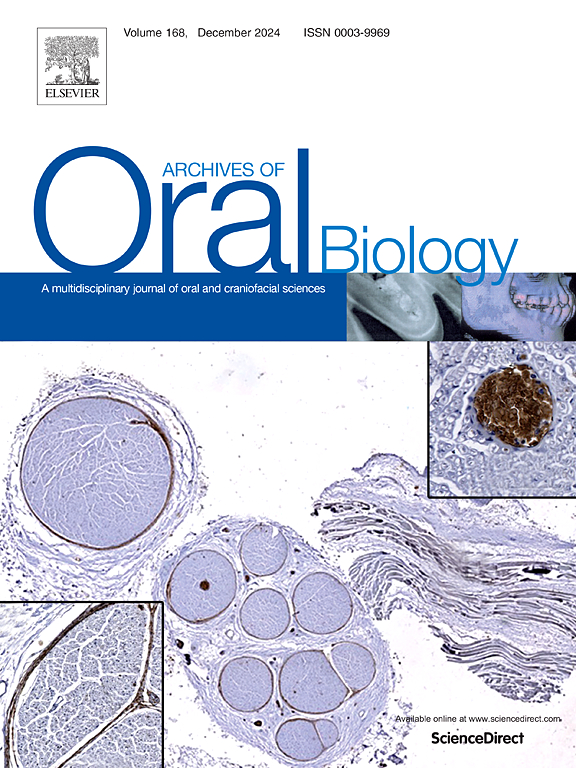Evaluation and characterization of the extracellular matrix in salivary gland tumors through histochemistry and second harmonic generation
IF 2.1
4区 医学
Q2 DENTISTRY, ORAL SURGERY & MEDICINE
引用次数: 0
Abstract
Objective
To describe extracellular matrix (ECM) components in salivary gland tumors with and without myoepithelial differentiation.
Design
Five cases of each tumor type were analyzed: pleomorphic adenoma, myoepithelioma, adenoid cystic carcinoma, myoepithelial carcinoma, epithelial-myoepithelial carcinoma, and salivary duct carcinoma. Histochemical stains identified collagen fibers, elastin, proteoglycans (PG), and glycosaminoglycans (GAG). Collagen was further examined by second harmonic generation (SHG) in three regions: tumor stroma, extratumoral stroma, and capsule. ImageJ was used to analyze area fraction, mean gray level, entropy, and contrast. Data underwent statistical analysis (p < 0.0001).
Results
ECM composition varied among salivary gland tumors. Pleomorphic adenoma showed low elastin and collagen, but PG and GAG were present in over 50 % of cases. Myoepithelioma showed variable collagen and elastin, while adenoid cystic carcinoma had predominant collagen. Myoepithelial carcinoma presented inconsistent elastin and low collagen. Epithelial-myoepithelial carcinoma and salivary duct carcinoma showed intense collagen staining. SHG revealed higher area fraction and gray level in the extratumoral region. Entropy was significantly higher outside the tumor. Malignant tumors with myoepithelial differentiation showed increased values in all SHG parameters compared to benign counterparts.
Conclusions
Benign tumors expressed more PG and GAG, whereas malignant ones had increased collagen with structural alterations. SHG analysis indicated lower collagen intensity within tumors and highlighted the role of ECM remodeling in malignancy, invasion, and metastasis.
唾液腺肿瘤细胞外基质的组织化学和二次谐波评价与表征
目的探讨有无肌上皮分化的唾液腺肿瘤细胞外基质(ECM)成分。设计分析多形性腺瘤、肌上皮瘤、腺样囊性癌、肌上皮癌、上皮-肌上皮癌和唾液管癌各5例。组织化学染色鉴定出胶原纤维、弹性蛋白、蛋白聚糖(PG)和糖胺聚糖(GAG)。在肿瘤间质、瘤外间质和囊膜三个区域进一步用二次谐波生成(SHG)检测胶原蛋白。ImageJ用于分析面积分数、平均灰度、熵和对比度。数据进行统计学分析(p <; 0.0001)。结果唾液腺肿瘤中secm的组成存在差异。多形性腺瘤表现为低弹性蛋白和胶原蛋白,但PG和GAG在50%以上 %的病例中存在。肌上皮瘤以胶原蛋白和弹性蛋白为主,腺样囊性癌以胶原蛋白为主。肌上皮癌表现为弹性蛋白不一致和胶原蛋白含量低。上皮-肌上皮癌和唾液管癌呈强烈的胶原染色。SHG显示瘤外区域的面积分数和灰度值较高。肿瘤外熵值明显增高。与良性肿瘤相比,具有肌上皮分化的恶性肿瘤的所有SHG参数值均升高。结论良性肿瘤中PG和GAG表达较多,恶性肿瘤中胶原蛋白表达增多,结构改变。SHG分析显示肿瘤内胶原蛋白强度较低,并强调了ECM重塑在恶性、侵袭和转移中的作用。
本文章由计算机程序翻译,如有差异,请以英文原文为准。
求助全文
约1分钟内获得全文
求助全文
来源期刊

Archives of oral biology
医学-牙科与口腔外科
CiteScore
5.10
自引率
3.30%
发文量
177
审稿时长
26 days
期刊介绍:
Archives of Oral Biology is an international journal which aims to publish papers of the highest scientific quality in the oral and craniofacial sciences. The journal is particularly interested in research which advances knowledge in the mechanisms of craniofacial development and disease, including:
Cell and molecular biology
Molecular genetics
Immunology
Pathogenesis
Cellular microbiology
Embryology
Syndromology
Forensic dentistry
 求助内容:
求助内容: 应助结果提醒方式:
应助结果提醒方式:


